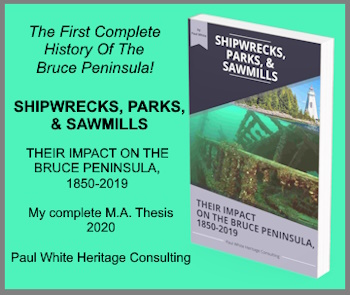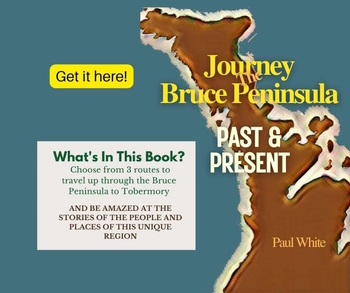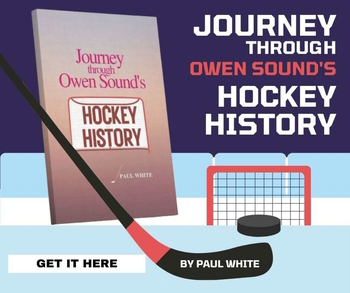Parry Sound
Shipping History
The Parry Sound area has always been connected to the southern regions of the Province of Ontario by a system of good roads. Or has it?
When the Parry Sound area was first opened for settlement the land routes followed by the pioneers were little better than forest trails. The rocky outcrops, dense bush, and, let’s not forget the mosquitoes and black flies, tested the mettle of even the hardiest pioneers as they made their way north to carve a new life out of the forested regions of the area.
But it was not long before a faster, more efficient and easier transportation route became popular. No, I am not talking about the building of Highway #69.
The growth of settlement on Georgian Bay’s eastern shore soon led to the creation of a network of shipping routes traversing the waterways connecting the Parry Sound area to the railhead at Collingwood as well as other Georgian Bay port communities.
These ships became the lifeline between the pioneering outback on both shores of Georgian Bay. Consequently, every autumn there was a race to get as much produce and supplies into the region as possible to help sustain the small settlements over the harsh winter months ahead.
After suffering the bitter cold of the winter freeze-up all eyes were cast towards the frozen bay waiting expectantly for the warm winds of spring that would melt the ice, heralding the coming of vessels laden with goods to restock empty larders.
The Beatty family of Thorold were among the leaders of the early development of maritime commerce on Georgian Bay. And, perhaps the symbol of this growth and the continuing interest in the maritime history of this region was one of their vessels, the Waubuno.
Parry Sound Shipping Tragedy:
The Sinking of the Waubuno
Just as its construction signalled the upsurge in the maritime shipping industry on the Bay, the disastrous demise of the Waubuno is also a symbol of the mystery, intrigue, and myth, which surrounds many of the wrecks that rest in the maritime graveyard that is Georgian Bay.
The Waubuno was built to serve the ever-growing demand for Georgina Bay's maritime transit vehicles. In 1865 the J. and W. Beatty Company of Thorold, owned by William Beatty Sr. and his sons, William, James H., John D., and Henry, hired one of the premier shipbuilders of that era, Melancthon Simpson, to build the 193-ton side wheel steamer Waubuno at Port Robinson.
The Beatty family were heavily involved in the lumbering industry in the Parry Sound area. To service the needs of this region and their commercial interests, the Beatty’s owned several ships including another vessel that would become one of the most famous, or infamous, depending upon your perspective, in the history of Georgian Bay shipwrecks, the Asia. When this vessel went down in 1882, with only two teenagers surviving from a passenger list and a crew that numbered 125.
The vessels owned by the Beatty family criss-crossed the Georgian Bay sea lanes much like the trucks, buses, and automobiles that traverse the highways of the Parry Sound region today. These varying types of vehicles all served the same purpose. They carried passengers and goods to and from the Parry Sound area.
However, the Beatty ships were not the only vessels plying Georgian Bay in the 1870s. There were many ships, both corporately and privately owned, vying for the maritime commercial trade on Georgian Bay. Perhaps the Beatty’s biggest rival was a Collingwood company, the Georgian Bay Transit Company. When this company put the 518-ton steamer, Northern Belle into service on the same Collingwood to Parry Sound route to compete with the Waubuno, the Beatty family acted to try and reduce competition. An agreement between the two companies was made. The result of these negotiations created the Georgian Bay Transportation Company Limited. The ships that sailed under the new company’s banner included the vessels Waubuno, Asia, Manitoulin, Northern Queen, and Emerald. Each would play a significant role in the development of the communities that ring the shoreline of Georgian Bay.
But with all of this maritime traffic, and the ever-increasing demand for goods and services as well as passenger traffic, accidents were bound to happen. Weather was often the factor that led to the demise of some of these majestic vessels and the loss of countless lives. But just as often it was the demands of competition that caused captains and crews to take risks that sometimes led to disaster.
Today, the remains of these wrecks can be found at the bottom of Georgian Bay. Diving to explore these symbols of the glorious era of maritime transportation on the Great Lakes has become a popular pastime for historians and recreational divers alike.
Georgian Bay Shipping
List of Lighthouses on the Great Lakes: If you have names and/or pictures of Great Lakes Lighthouses please submit them along with details of their location.
Georgian Bay Ships: A List of all the ships that sailed on Georgian Bay until the 1960s. This list is not complete. If you know of a ship that sailed the waters of Georgian Bay please contact me with information about that vessel, and, if you have a picture that I could post with it, that would be much appreciated.
1885: A Memorable Summer Job for Owen Sound teenage boys on the Great Lakes would have historic importance, not mention a possible exciting career opportunity.
Hindman Transportation Company was a well-known Great Lakes shipping company for many years. Here you will find pictures of many of the Hindman ships
Owen Sound Harbour – A Photographic History, by Robert A. Cotton is a book that interests my historiographical curiosity.
Commercial Great Lakes Fishing It is probably safe to suggest that the commercial fishing industry was an important part of the early growth of this region.
A Georgian Bay fishing vacation has long been a popular attraction in the Bruce Peninsula region. During fishing derbies, the regional waterways are dotted with fishing boats of all shapes and sizes.
The Georgian Bay Mackinaw, designed by William Watts of Collingwood is an example of a Georgian Bay innovator creating a vessel to service the needs local mariners.
Great Lakes fishing is an asset that is protected and developed, not only for its economic potential but also for those who just enjoy spending a day by the side of a river or in small fishing boats trying to catch “the big one”!
Great Lakes Fishing History is not without its controversy. The impact of the fishing industry was such that it played an important role in the development of communities along the Georgian Bay and Lake Huron shoreline.
Georgian Bay Travel Before the Winter Freeze-Up could be a dangerous time for mariners in the early years in this region.
A Harbinger of Spring on the Great Lakes in pioneer times, was the eagerly awaited news that a lighthouse had been lit and shipping traffic could begin sailing from port to port.
Lumber Hookers Lumber hookers and tugs were an important innovation to improve the transportation of lumber on Georgian Bay.
Mapmakers on Georgian Bay were also explorers. They mapped the Georgina Bay shoreline noting safe harbours, dangerous reefs and other guides for sailors and pioneer settlers looking for a place to call home.
Paddling Georgian Bay & Pondering: traversing parts of this great waterway in a canoe leads one to wonder about the ships of a bygone era battling the rough seas they encountered.
Parry Sound Shipping History: The Parry Sound area has always been connected to the southern regions of the Province of Ontario by a system of good roads. Or has it?
Parry Sound’s shipping history 2 is more than the tragic sinking of the Waubuno or the later catastrophe surrounding the sinking of the Asia.
Sailing Season Closing: A Frantic Time on Peninsula as ships raced from port to port delivering and picking up passengers and produce before the waterways froze.
Ship Captain Andrew Port was not only a dynamic and brave Georgian Bay mariner, he was a personal favourite historical character of mine.
Ships Stuck in Ice: The Oak Glen was icebound in 1996 but this sailing hazard has been impacting vessels on Georgian Bay since the beginning of time.
Lake Huron shipwrecks, the Hibou often occurred in the Georgian Bay region of that Great Lake due to the often violent waters that could strike unsuspecting vessels like the Hibou.
Shipwrecks: The "Asia" wrecked off the eastern coast of Georgian Bay taking all but two of the more than 100 passengers to a watery grave.
Masters, Mates, and Pilots Association created its first Canadian chapter on Georgian Bay, providing maritime safety education, and other seafaring issues to better inform its membership.
Pioneer Travel Aboard the Fly Tells the story of a sailing vessel as the tenuous link between survival and death in a pioneer settlement in the 1840's in Upper Canada.
Sailing Stories: the Captain Who Smelled his way into Port The Captain Who Smelled his Way into Port details how pioneer seamen on Georgian Bay safely sailed the rough waters without the aid of the modern technological tools so readily used by today's mariners.
Sailing Story: The Voyage of the Prince Alfred the incredible voyage of the Prince Alfred, fraught with danger for both vessel and the crew in the winter of 1880.
Shipbuilding As the southern Georgian Bay region became more populated shipping traffic increased to meet the needs of an expanding market place.
The Summer of 1844 was No Picnic for the early settlers in the pioneer area near what would become Owen Sound on Georgian Bay.
The CPR Grain Elevator Fire of 1911 spelled the end of Owen Sound's role as the eastern terminus of the CPR Great Lakes Fleet.
Georgian Bay shipping occurred long before the first Europeans paddled these waters. But the fur and timber trades opened Georgian Bay to shipping in a big way!





